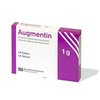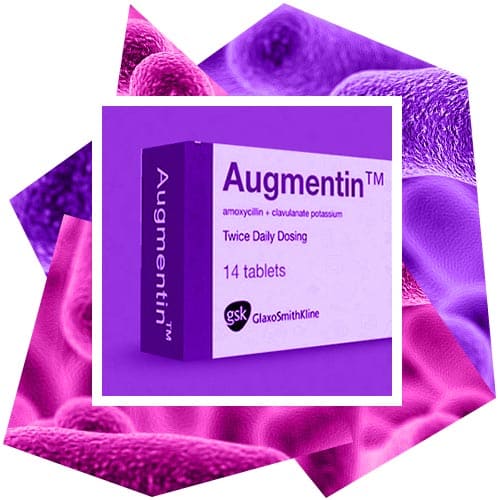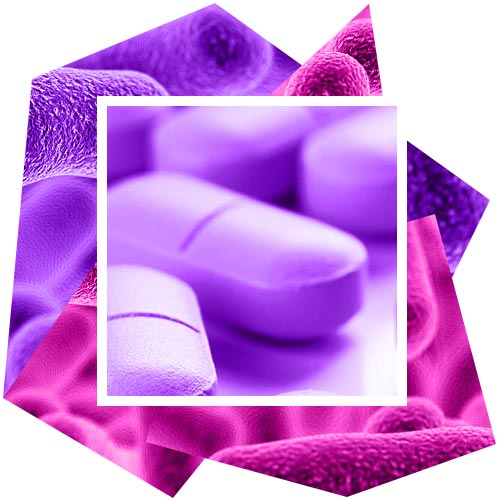Pharmacodynamics
Amoxicillin is a semi-synthetic broad-spectrum antibiotic with activity against many gram-positive and gram-negative microorganisms. At the same time, amoxicillin is susceptible to destruction by beta-lactamases, and therefore the spectrum of activity of amoxicillin does not extend to microorganisms that produce this enzyme.
Clavulanic acid, a beta-lactamase inhibitor structurally related to penicillins, has the ability to inactivate a wide range of beta-lactamases found in penicillin and cephalosporin resistant microorganisms. Clavulanic acid is sufficiently effective against plasmid beta-lactamases, which are most often responsible for bacterial resistance, and is less effective against chromosomal beta-lactamases of the 1st type, which are not inhibited by clavulanic acid.
The presence of clavulanic acid in the Augmentin preparation protects amoxicillin from destruction by enzymes - beta-lactamases, which allows to expand the antibacterial spectrum of amoxicillin.
The following is the in vitro combination activity of amoxicillin with clavulanic acid.

Bacteria commonly susceptible to a combination of amoxicillin with clavulanic acid
- Gram-positive aerobes. Bacillus anthracis, Enterococcus faecalis, Listeria monocytogenes, Nocardia asteroides, Streptococcus spp., Incl. Streptococcus pyogenes, Streptococcus agalactiae (other beta hemolytic streptococci), Staphylococcus aureus (sensitive to methicillin), Staphylococcus saprophyticus (sensitive to methicillin), coagulase-negative staphylococci (sensitive to methicillin).
- Gram-positive anaerobes. Clostridium spp., Peptococcus niger, Peptostreptococcus spp., Including Peptostreptococcus magnus, Peptostreptococcus micros.
- Gram-negative aerobes. Bordetella pertussis, Haemophilus influenzae, Helicobacter pylori, Moraxella cafarrhalis, Neisseria gonorrhoeae, Pasteurella multocida, Vibrio cholerae.
- Gram-negative anaerobes. Bacteroides spp., Incl. Bacteroides fragilis, Capnocytophaga spp., Eikenella corrodens, Fusobacterium spp., Including Fusobacterium nucleatum, Porphyromonas spp., Prevotella spp.
- Other. Borrelia burgdorferi, Leptospira icterohaemorrhagiae, Treponema pallidum.
Bacteria for which acquired resistance to a combination of amoxicillin with clavulanic acid is likely
- Gram-negative aerobes. Escherichia coli, Klebsiella spp., Incl. Klebsiella oxytoca, Klebsiella pneumoniae, Proteus spp., Including Proteus mirabilis, Proteus vulgaris, Salmonella spp., Shigella spp.
- Gram-positive aerobes. Corynebacterium spp., Enterococcus faecium, Streptococcus pneumoniae, streptococci of the Viridans group.
Bacteria that are naturally resistant to the combination of amoxicillin with clavulanic acid
- Gram-negative aerobes. Acinetobacter spp., Citrobacter freundii, Enterobacter spp., Hafnia alvei, Legionella pneumophila, Morganella morganii, Providencia spp., Pseudomonas spp., Serratia spp., Stenotrophomonas maltophilia, Yersinia enter.
- Other. Chlamydia spp., Incl. Chlamydia pneumoniae, Chlamydia psittaci, Coxiella burnetii, Mycoplasma spp.
Pharmacokinetics
Suction
Both active ingredients of the drug Augmentin - amoxicillin and clavulanic acid - are quickly and completely absorbed from the gastrointestinal tract after oral administration. The absorption of the active substances of the drug Augmentin is optimal in case of taking the drug at the beginning of a meal.
Distribution
As with iv administration of a combination of amoxicillin with clavulanic acid, therapeutic concentrations of amoxicillin and clavulanic acid are found in various tissues and interstitial fluid (gall bladder, abdominal tissues, skin, fat and muscle tissue, synovial and peritoneal fluids, bile, purulent discharge )
Amoxicillin and clavulanic acid have a weak degree of binding to plasma proteins. Studies have shown that about 25% of the total amount of clavulanic acid and 18% of amoxicillin in blood plasma binds to blood plasma proteins.
In animal studies, no cumulation of the components of the Augmentin® preparation in any organ was found.
Amoxicillin, like most penicillins, passes into breast milk. Traces of clavulanic acid may also be found in breast milk. With the exception of the possibility of developing diarrhea and candidiasis of the oral mucous membranes, no other negative effects of amoxicillin and clavulanic acid on the health of breast-fed babies are known.
Animal reproductive studies have shown that amoxicillin and clavulanic acid cross the placental barrier. However, no adverse effects on the fetus were detected.
Metabolism
10–25% of the initial dose of amoxicillin is excreted by the kidneys as an inactive metabolite (penicilloic acid). Clavulanic acid is extensively metabolized to 2,5-dihydro-4- (2-hydroxyethyl) -5-oxo-3H-pyrrole-3-carboxylic acid and amino-4-hydroxy-butan-2-one and excreted via the kidneys Gastrointestinal tract, as well as with expired air in the form of carbon dioxide.
Breeding
Like other penicillins, amoxicillin is excreted mainly by the kidneys, while clavulanic acid is excreted by both the renal and extrarenal mechanisms.
About 60–70% of amoxicillin and about 40–65% of clavulanic acid are excreted by the kidneys unchanged in the first 6 hours after administration.
The simultaneous administration of probenecid slows the excretion of amoxicillin, but not clavulanic acid.
Indications for the drug Augmentin
The combination of amoxicillin with clavulanic acid is indicated for the treatment of bacterial infections of the following locations caused by microorganisms sensitive to the combination of amoxicillin with clavulanic acid:
- upper respiratory tract infections (including ENT infections), for example, recurrent tonsillitis, sinusitis, otitis media, usually caused by Streptococcus pneumoniae, Haemophilus influenzae, Moraxella catarrhalis and Streptococcus pyogenes;
- lower respiratory tract infections, such as exacerbations of chronic bronchitis, lobar pneumonia and bronchopneumonia, usually caused by Streptococcus pneumoniae, Haemophilus influenzae and Moraxella catarrhalis;
- urinary tract infections, for example, cystitis, urethritis, pyelonephritis, female genital infections, usually caused by species of the Enterobacteriaceae family (mainly Escherichia coli), Staphylococcus saprophyticus and species of the genus Enterococcus, as well as gonorrhea caused by Neisseria gonorrhoeae;
- infections of the skin and soft tissues, usually caused by Staphylococcus aureus, Streptococcus pyogenes, and species of the genus Bacteroides;
- infections of bones and joints, for example osteomyelitis, usually caused by Staphylococcus aureus, if necessary, prolonged therapy is possible;
- odontogenic infections, for example periodontitis, odontogenic maxillary sinusitis, severe dental abscesses with spreading cellulitis;
- other mixed infections (eg, septic abortion, postpartum sepsis, intra-abdominal sepsis) as part of step therapy;
Infections caused by microorganisms sensitive to amoxicillin can be treated with Augmentin, since amoxicillin is one of its active ingredients. Augmentin is also indicated for the treatment of mixed infections caused by microorganisms sensitive to amoxicillin, as well as microorganisms producing beta-lactamase, sensitive to the combination of amoxicillin with clavulanic acid.
The sensitivity of bacteria to the combination of amoxicillin with clavulanic acid varies depending on the region and over time. Where possible, local sensitivity data should be taken into account. If necessary, microbiological samples should be collected and analyzed for bacteriological sensitivity.
Contraindications
For all dosage forms
- hypersensitivity to amoxicillin, clavulanic acid, other components of the drug, beta-lactam antibiotics (e.g. penicillins, cephalosporins) in history
- previous episodes of jaundice or impaired liver function when using a combination of amoxicillin with clavulanic acid in history.

Pregnancy and Lactation
In studies of reproductive functions in animals, oral and parenteral administration of Augmentin did not cause teratogenic effects.
In a single study in women with premature rupture of the membranes, it was found that prophylactic therapy with Augmentin may be associated with an increased risk of necrotizing enterocolitis in newborns. Like all drugs, Augmentin is not recommended for use during pregnancy, unless the expected benefit to the mother outweighs the potential risk to the fetus.
The drug Augmentin can be used during breastfeeding. With the exception of the possibility of developing diarrhea or candidiasis of the mucous membranes of the oral cavity associated with the penetration of trace amounts of the active substances of this drug into breast milk, no other adverse effects were observed in breast-fed infants. In case of adverse effects in infants who are breast-feeding, it is necessary to stop breast-feeding.
Side Effects
The adverse events presented below are listed in accordance with the damage to organs and organ systems and the frequency of occurrence. The frequency of occurrence is determined as follows: very often - ≥1 / 10; often - ≥1 / 100 and <1/10; infrequently - ≥1 / 1000 and <1/100; rarely - ≥1 / 10000 and <1/1000; very rarely - <1/10000, including isolated cases. Frequency categories were formed on the basis of clinical studies of the drug and post-registration observation.
Infectious and parasitic diseases: often - candidiasis of the skin and mucous membranes.
On the part of the blood and lymphatic system: rarely - reversible leukopenia (including neutropenia), reversible thrombocytopenia; very rarely - reversible agranulocytosis and reversible hemolytic anemia, prolonged bleeding and PV, anemia, eosinophilia, thrombocytosis.
From the immune system: very rarely - angioedema, anaphylactic reactions, a syndrome similar to serum sickness, allergic vasculitis.
From the nervous system: infrequently - dizziness, headache; very rarely - reversible hyperactivity, convulsions (convulsions can occur in patients with impaired renal function, as well as in those who receive high doses of the drug), insomnia, agitation, anxiety, and behavior change.
From the gastrointestinal tract:
- adults: very often - diarrhea; often - nausea, vomiting;
- children: often - diarrhea, nausea, vomiting;
- entire population: nausea was most often associated with the use of high doses of the drug. If after the start of taking the drug there are undesirable reactions from the gastrointestinal tract, they can be eliminated if Augmentin is taken at the beginning of the meal; infrequently - digestion; very rarely - antibiotic-associated colitis (including pseudomembranous colitis and hemorrhagic colitis), black “hairy” tongue, gastritis, stomatitis; discoloration of the surface layer of tooth enamel in children. Oral care helps prevent discoloration of the teeth, since brushing your teeth is enough.
From the liver and biliary tract: infrequently - a moderate increase in the activity of AST and / or ALT. This phenomenon is observed in patients receiving beta-lactam antibiotic therapy, but its clinical significance is unknown. Very rarely - hepatitis and cholestatic jaundice. These phenomena are observed in patients receiving therapy with penicillin antibiotics and cephalosporins. Increased concentrations of bilirubin and alkaline phosphatase.
Adverse effects from the liver are observed mainly in men and elderly patients and may be associated with long-term therapy. These adverse events are very rarely observed in children.
The listed signs and symptoms usually occur during or immediately after the end of therapy, but in some cases they may not appear for several weeks after completion of therapy. Adverse events are usually reversible. Adverse events from the liver can be severe, in extremely rare cases there have been reports of fatal outcomes. In almost all cases, these were patients with serious concomitant pathology or patients receiving potentially hepatotoxic drugs.
On the part of the skin and subcutaneous tissues: infrequently - rash, itching, urticaria; rarely - erythema multiforme; very rarely - Stevens-Johnson syndrome, toxic epidermal necrolysis, bullous exfoliative dermatitis, acute generalized exanthematous pustulosis.
In case of skin allergic reactions, treatment with Augmentin should be discontinued.
From the kidneys and urinary tract: very rarely - interstitial nephritis, crystalluria, hematuria.
Interaction
The simultaneous use of the drug Augmentin and probenecid is not recommended. Probenecid reduces the tubular secretion of amoxicillin, and therefore the simultaneous use of the drug Augmentin and probenecid can lead to an increase in blood concentration and concentration of amoxicillin, but not clavulanic acid.
The simultaneous use of allopurinol and amoxicillin may increase the risk of skin allergic reactions. Currently, there is no data in the literature on the simultaneous use of a combination of amoxicillin with clavulanic acid and allopurinol.
Penicillins can slow the elimination of methotrexate from the body by inhibiting its tubular secretion, so the simultaneous use of Augmentin and methotrexate may increase the toxicity of methotrexate.
Like other antibacterial drugs, the drug Augmentin can affect the intestinal microflora, leading to a decrease in the absorption of estrogen from the gastrointestinal tract and a decrease in the effectiveness of combined oral contraceptives.
The literature describes rare cases of an increase in MHO in patients with the combined use of acenocumarol or warfarin and amoxicillin. If necessary, the simultaneous administration of the Augmentin drug with anticoagulants PV or MHO should be carefully monitored when prescribing or discontinuing the Augmentin drug; dose adjustment of anticoagulants for oral administration may be required.
Dosage and Administration
Inside
The dosage regimen is set individually, depending on the age, body weight, kidney function of the patient, as well as the severity of the infection.
To reduce the potential possible gastrointestinal disturbances and to optimize absorption, the drug should be taken at the beginning of a meal. The minimum course of antibiotic therapy is 5 days.
Treatment should not continue for more than 14 days without a review of the clinical situation.
If necessary, it is possible to carry out stepwise therapy (first parenteral administration of the drug with subsequent transition to oral administration).
Low doses of Augmentin are recommended for the treatment of infections of the skin and soft tissues, as well as recurrent tonsillitis.
High doses of Augmentin are recommended for the treatment of diseases such as otitis media, sinusitis, infections of the lower respiratory tract and urinary tract, infection of bones and joints.
Children from birth to 3 months. Due to immaturity of the excretory function of the kidneys, the recommended dose of Augmentin (calculated according to amoxicillin) is 30 mg / kg / day in 2 divided doses of 4: 1.
Babies born prematurely. There are no recommendations regarding the dosage regimen.
Special patient groups
Elderly patients. Correction of the dosage regimen is not required; the same dosage regimen is applied as in younger patients. In elderly patients with impaired renal function, appropriate doses are prescribed for adult patients with impaired renal function.
Patients with impaired liver function. Treatment is carried out with caution; regularly monitor liver function. There is not enough data to change the dose recommendations in such patients.
Patients with impaired renal function. The correction of the dosage regimen is based on the maximum recommended dose of amoxicillin and creatinine clearance value.
Overdose
Symptoms: can be observed from the gastrointestinal tract and disturbances in the water-electrolyte balance.
Amoxicillin crystalluria is described, in some cases leading to the development of renal failure.
Seizures in patients with impaired renal function, as well as in those who receive high doses of the drug.
Treatment: gastrointestinal symptoms - symptomatic therapy, with particular attention to normalizing the water-electrolyte balance. Amoxicillin and clavulanic acid can be removed from the bloodstream by hemodialysis.
The results of a prospective study conducted with 51 children in a poison center showed that the administration of amoxicillin at a dose of less than 250 mg / kg did not lead to significant clinical symptoms and did not require gastric lavage.
 US
US UK
UK CA
CA DE
DE FR
FR IT
IT ES
ES







